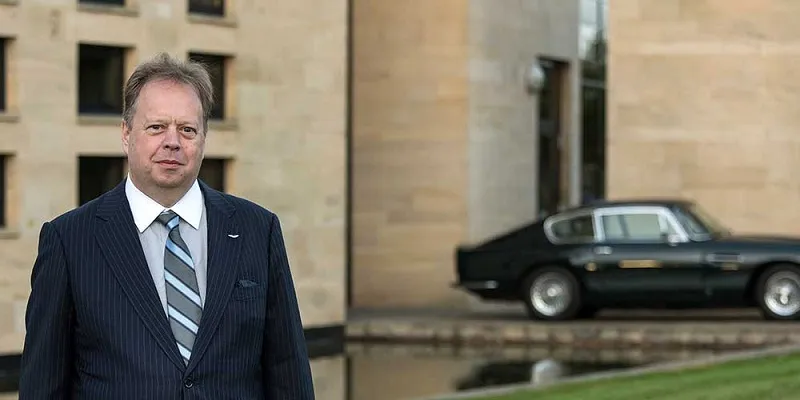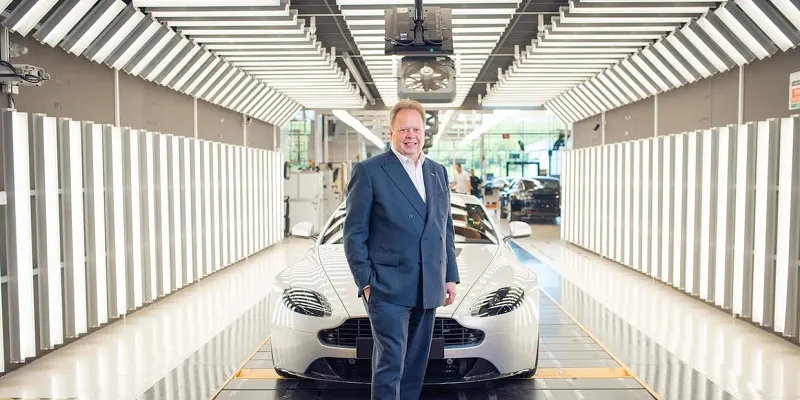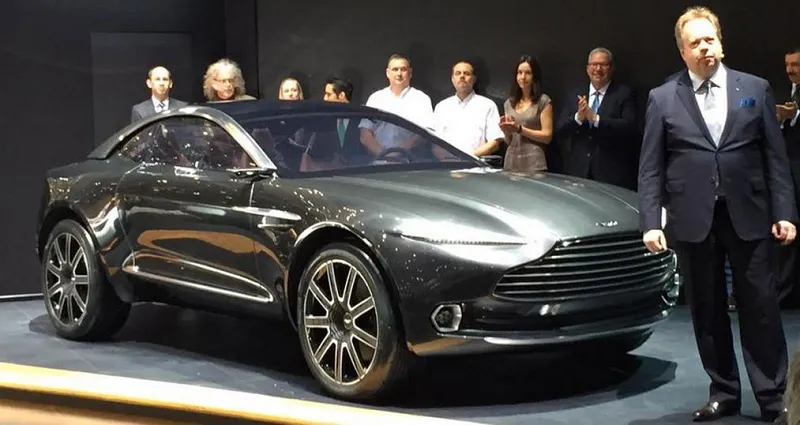[The Big Interview] Want to drive James Bond’s car? Then look beyond the 'clicks and bytes' life, says Andy Palmer, CEO, Aston Martin
Aston Martin embodies a personality. The company has been hand-crafting cars for connoisseurs for over a century. In films, the car has been immortalised as the automobile of choice for the fictional British MI-6 agent James Bond.
The car is also every young businessman’s dream. But, you see very few Aston Martins in India and most of them still remain imported. They certainly catch your eye when they glide past you on the road. Yet the question remains as to how the company is reinventing itself in an age that is ushering in the rise of connected cars and autonomous vehicles.
Aston Martin’s top management is not shaken by these developments because they believe that their cars are to be driven and not to be confused with gadgetry. Technology for the company is in making the best sports-class engines and researching on light weighting the aluminium chassis.

In an exclusive interview with YourStory, Andrew (Andy) Palmer, CEO of Aston Martin, gives the lowdown on what is going on at Aston Martin ever since he took over two years ago. He was tasked with restoring faith in a company which did not have a CEO between 2011 and 2013. The company was also losing ground and Andrew had to bring it back on track as an iconic brand.
Under Andy, the company harbours big plans for the future, and by 2019, it intends to add an all-new crossover vehicle to production at a new plant in Wales. The company is also building an electric sports vehicle called RapidE that will hit the market by 2018.
To up its game as the preferred luxury sports car brand, the company is investing close to $915 million.
Palmer also believes that the US, India, China, and other countries across the Asia Pacific hold the most potential – in the coming years. Just like punk rock, which happens to be Palmer's favourite type of music, he believes a sports car like Aston Martin's is a timeless classic.
Here are the excerpts of the interview:
YS: Aston Martin has maintained its iconic status for generations. As its CEO in an age of Internet-of-Things and changing social trends, what is your business roadmap for the brand to catch the attention of the connoisseur of the new era?
Palmer: At Aston Martin, everything we do is for the love of “beautiful”. This guiding light has defined the company back to its foundation in London in 1913. Today, that mission is as relevant as it was when the company was founded. Whether it is the beautiful proportions of our cars (always following the laws of nature), the beautiful materials we use in production or the very way in which we hand-craft every car at our factory in England.
In an age driven by “clicks and bytes”, the values of Aston Martin are, if anything, more relevant today than at any time in the past. We don’t make a commodity product nor do we make very many. Our cars are bought and sold like fine art, collectors realising that the combination of beauty and rarity are the same values that will continue to create desire in the future. Although we may be appreciated like fine art, we are firmly focussed on the latest technologies, whether that is our bonded aluminium chassis or an all-new 5.2-litre twin-turbo V12 engine.
YS: How do you approach the social trends set by the millennial generation, which can potentially last for the next 20 years? In that context do you observe these trends, and what could they be?
Palmer: All our cars are created to meet the needs of a specific customer cluster (a group of like-minded people that are looking for similar attributes in a car). We create a proxy persona customer to represent the centre of each cluster. Then we do our utmost to make the best possible car for that cluster of customers. Given the length of time it takes to develop a new vehicle and their duration on sale, we are already focussed on meeting the future needs of consumers in the Generation Y cohort who, in markets like India and China, are emerging rapidly as the next-generation of luxury consumers.

YS: Please talk about R&D in your company - how much does Aston Martin spend on R&D?
Palmer: To support the regeneration and expansion of our product range under our 'Second Century' business plan (2015 to 2020), we will invest over £700 million or $915 million into new products and technologies. The new V12 engine in the new DB11 was developed in-house. It is the first time we've adopted turbo-chargers, in this case, on the V12 5.2l twin turbo chargers. Idle stop and cylinder bank deactivation being specific technologies to improve fuel consumption. The DB11 leads in the use of bonded aluminium chassis. Shortly after the adhesive is applied, it is cured in ovens that simultaneously heat-treat the metal. We also excel in aerodynamic technology visible with DB11's aero-blade feature - an invisible spoiler. In India, we are working with Hinduja Tech and through them we are looking to increasingly source parts.
YS: Do you see sports/luxury car brands investing in hybrid engine/battery technology - if so please substantiate on trends that Aston is looking at, including the concept of a connected car?
Palmer: We are developing RapidE, an electric sports car to be launched in 2018. We already see Kinectic Energy Recovery Systems (KERS)-type of applications now appearing in many sports cars, and I believe it is inevitable that we will see a more diverse power train line-up in the sports luxury sector.
We will not lead in autonomous technology. Astons are to be driven. Nevertheless, due to our relationship with Daimler we can adopt as necessary. We concentrate on only technology we think that is useful to drivers such as automatic parking and around-view monitors. We are also excited about the potential for autonomous driving technologies to be used to enhance the performance of driving experience.
YS: Your views on Aston having a focussed partner in India, or do you plan to invest on your own dealers? What is your strategy for this market and other emerging markets?
Palmer: Around the world, we have many Indian customers. However, imports into India are difficult given the high tariffs barriers. It's impossible for a company making between 4,000 and 7,000 cars a year to imagine local assembly in India. We would like to see the elimination of tariffs for small vehicle manufacturers.

YS: Talk a bit about yourself in Aston. What are the key best moments over the last two years?
Palmer: I have probably experienced more intense emotions at Aston Martin than at any other time in my career. My first day at work was naturally memorable as I went directly to speak to our workforce; they had been without a CEO for over two years. Although there have been many tough days, there have been many highlights including the launch of our Second Century Turnaround Plan in early 2015, the launch of the DB11 at the Geneva Show this year and the reveal, in front of all our employees at Gaydon, of the stunning AM-RB001 hypercar. Building the business apart I am also a member of the Aston Martin Owners Club. There is a very active AMOC all over the world and it is really like being part of a family.
As the owner of a 1981 V8 Aston Martin, I am naturally a proud member of the club! We have many projects in place to engage our customers. I am most excited about the extension of our brand through experiences – such as attending a motor race or the Pebble Beach Concours. We call it the ‘Art of Living’ and we have already hosted many customers on different programmes.
YS: Would you like to add a little about Aston's progress in the USA, China and Europe?
Palmer: Between now and 2020, we expect our sports car production max out our manufacturing capacity of 7,000 vehicles a year. In 2019 we will add an all-new crossover vehicle. Investment in product and brand will drive a large percentage increase in our growth, but in the context of our industry, we will still be rare and exclusive. The markets with the most growth potential over the coming years are the US, China and across Asia Pacific.

YS: Do you want to comment on Britain's exit from Europe and how it may impact globalisation, does it impact companies and corporate if nations pull out from markets?
Palmer: In the period before the referendum vote, we took the very deliberate decision not to make our views known externally. We wanted to respect the right of our employees to vote on Brexit based on their own assessment of the pros and cons. In the end, we are business people and we have to manage whatever scenario unfolds. We don’t see the UK being isolated from the EU given the size and inter-connectivity of our trading relations. That said, life will change and we will work to ensure that we are structured to profit from whatever scenarios unfold.


![[The Big Interview] Want to drive James Bond’s car? Then look beyond the 'clicks and bytes' life, says Andy Palmer, CEO, Aston Martin](https://images.yourstory.com/cs/wordpress/2016/08/Aston-One.jpg?mode=crop&crop=faces&ar=16%3A9&format=auto&w=1920&q=75)




